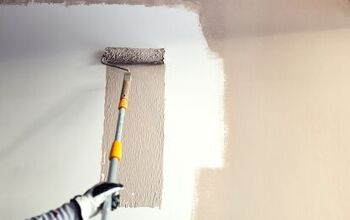Can You Paint Electrical Outlets? (Find Out Now!)

Electrical outlets can be an eyesore when you finish painting a room. Often these outdated fixtures do not match with the sleek clean look that a fresh coat of paint brings. You may want to use the last of your wall paint to cover the outlets and create a seamless look.
Before you pick your brush up again and begin to paint them it is important to understand the many safety and logistical concerns involved when you paint an electrical outlet.
If you decide to paint your electrical outlet you should only paint the outlet cover. Painting the electrical socket can cause dangerous conductivity and fire. When you paint the outlet cover be sure to remove it from the wall first. Use a non-flammable and non-conductive paint. Look into replacement outlet and socket covers, as these products may be cheaper and easier to install than painting the electrical outlet yourself.
It is crucial to know the potential dangers of painting electrical outlets before you begin preparations to paint them. Once you understand the risks and hazards involved in this project you can prepare accordingly to ensure you do the job safely.
Do You Need Painting or Staining Services?
Get free, zero-commitment quotes from pro contractors near you.

Hazards of Painting Electrical Outlets
Clogged Outlets
When you paint an outlet there is always a risk that paint will wear off the outlet surface and lodge itself into the socket itself. Any buildup inside a socket will render the socket unreliable as it is blocked.
Additionally, a clogged electrical socket can cause heat buildup. Heat buildup in an electrical socket for an extended period of time can lead to a fire or a short circuit in the outlet. This is one reason that the electrical socket itself should never be painted.
Paint Is Often Flammable
Many paints are flammable. Enamel, lacquer, and other oil-based paints are highly flammable. Additionally, many paints have a flammable element to them. Water-based paints are generally safer but they can be conductive, which is also dangerous.
Dangerous Conductivity
Many paints act as conductors. Water-based paints and acrylic paints are particularly conductive. If the painted surface comes in contact with electricity it can cause very dangerous and unregulated conductivity. It can trigger devices to connect and disconnect rapidly.
This dangerous conductivity can cause a short circuit and potential sparks and fire. Devices plugged into these sockets can be damaged by this conductivity.
Use The Correct Paint
When you purchase paint to cover your electrical outlet cover be sure to choose the safest paint possible. You need a paint that is both non-conductive and non-flammable.
Spray paint is the easiest type of paint to use when you paint an electrical outlet panel. It goes on with thin coats that are less likely to chip or wander into the electrical socket. Find a spray paint that is both non-conductive and non-flammable.
Leave The Socket Alone
Be sure to never paint the electrical socket, even when you buy the correct and safest paint possible. Electricians advise that you should never paint an electrical socket. Spray paint can be particularly dangerous.
If you paint the socket or get paint near it then you risk clogging the socket. Paint on or in the electrical socket is very dangerous, and will likely render the socket unreliable. There are several safe alternatives to painting the electrical socket that you can pursue instead.
Paint Outlet Cover Safely
When you paint an electrical outlet you should paint the outlet cover only. The cover should be removed from the wall to prevent paint landing in unwanted areas.
- Setup The Paint Area. You will need cardboard or newspapers covering your work area. This will ensure no spray paint gets on your floor. This is where your outlet cover and screws will go when you paint them.
- Unscrew the outlet cover. Do not paint the outlet cover when it is connected to the electrical outlet. This could lead to paint in the electrical socket, which is very dangerous. Once the cover is unscrewed, save the screws and carefully remove the outlet cover from the wall.
Tip: There will be exposed wires when you remove the outlet cover. If you are unfamiliar with the electrical work in your home, or want to be cautious, you can cut off the electricity to the outlet using your circuit breaker.
- Clean Outlet Cover. Almost all outlet covers are made of some form of plastic. In order to get paint to stick to this plastic you must clean and prime the surface. Clean the surface with a microfiber rag with water and cleaning solution. Be sure the outlet cover is completely dry before you move on to the next step.
- Use A Primer. Use a non-flammable and non-conducting primer spray to coat the outlet cover. A primer coat will help the paint layer stick to the plastic. If you do not use a primer coat the paint may not adhere properly to the plastic.
- Paint The Cover. Use the spray paint you selected for its safety and color. Be sure to read the paint can in order to know exactly how far you need to hold the can when you spray paint the electrical outlet cover.
Tip: Paint very thin layers of paint. It may take up to three coats of spray but thin layers will ensure a very even finish without any signs of extra dripping paint.
Consult A Professional
You should be confident any time you make a home improvement that involves electricity. Do ample research on power outlets and how they conduct electricity before you begin a project to improve them. If you are unfamiliar with electricity and conductivity, consult a professional.
There are several online forums that can assist you with questions. If you are doing a large home improvement project that will involve electrical work you may want to look into electrician rates for a consultation.
Buy A New Outlet Cover
Before you purchase all the paint supplies needed to paint your electrical outlets, you may want to tally the costs. There is a good chance you can purchase new outlet covers in the exact color and shade you desire.
Electrical outlets come in many different shapes and styles, and there are a variety of colors for all these styles. Additionally, you can get a socket cover, which will cover your electrical socket as well and match it with your desired color. These socket covers help give a seamless look to the outlet safely.
Related Questions
Can I Replace Electrical Outlets Myself?
It is possible for you to replace your electrical outlet yourself. However, you should do research on the topic before you prepare to perform this task yourself. You should only replace an electrical outlet yourself if you have a strong understanding of electricity.If you do not follow steps exactly you can shock and seriously injure yourself. If you install an electrical outlet incorrectly you can cause reverse polarity on your home, which can be very dangerous.
When should I Change Out My Electrical Outlets?
Electrical outlets, like most home repairs, should be replaced periodically to ensure they work properly and are up to date. Many people do not change electrical outlets on a schedule. Instead, outlets are often only replaced when something goes wrong with an outlet or there is a problem with the electricity.It is best practice to change a frequently used outlet at least every 15 years. When you change an outlet every 15 years you ensure your outlets are operating effectively and your home is staying up to date with innovations in electronics.
What Paint Should I Use On Plastic Surfaces?
There are several methods you can use to ensure paint sticks to plastic. If you have a simple project you can always purchase a can of spray paint. There are several types of spray paint that are made specifically to adhere to plastics. When you use a primer that is designed to adhere to plastics you can greatly increase the longevity of your paint job. Primer acts as a bonding layer that your paint will adhere to well. Be sure to choose a primer or primer spray designed for plastics.
Do You Need Painting or Staining Services?
Get free, zero-commitment quotes from pro contractors near you.

Summing It Up
Do not rush to paint your electrical outlets even if they are drab in appearance. Before you purchase paint and materials you should understand the potential dangers involved when you paint your electrical outlets. If you paint your outlet incorrectly or use the wrong paint you can create a fire hazard and even an unreliable electrical current.
Additionally, you should first estimate the costs involved in painting your electrical outlets. There are many outlet covers and socket covers you can purchase online or at a hardware store. These replacements may be just what you are looking for and they might cost less.
If you decide to paint your electrical outlet yourself, be sure to select the right paint. Use a non-flammable and non-conductive paint. Be sure to remove the outlet cover from the wall as it is crucial you do not get paint on the electrical socket.

Tom Gaffey is an expert writer who currently resides in Washington D.C. Tom has a passion for real estate and home improvement writing, as well as travel and lifestyle writing. He lived the last twelve years in Hawaii where he worked closely with luxury resorts and event planners, mastering his knowledge of aesthetics and luxury products. This is where he found his passion for home improvement and a keen interest in DIY projects. Currently, Tom resides in Washington D.C, and also working on his debut fiction novel.
More by Tom Gaffey





















![Cost To Drill A Well [Pricing Per Foot & Cost By State]](https://cdn-fastly.upgradedhome.com/media/2023/07/31/9074980/cost-to-drill-a-well-pricing-per-foot-cost-by-state.jpg?size=350x220)





